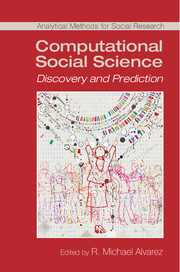Book contents
- Frontmatter
- Contents
- Preface
- Introduction
- PART 1 COMPUTATIONAL SOCIAL SCIENCE TOOLS
- 1 The Application of Big Data in Surveys to the Study of Elections, Public Opinion, and Representation
- 2 Navigating the Local Modes of Big Data: The Case of Topic Models
- 3 Generating Political Event Data in Near Real Time: Opportunities and Challenges
- 4 Network Structure and Social Outcomes: Network Analysis for Social Science
- 5 Ideological Salience in Multiple Dimensions
- 6 Random Forests and Fuzzy Forests in Biomedical Research
- PART 2 computational social science applications
- Conclusion Computational Social Science: Toward a Collaborative Future
- Index
4 - Network Structure and Social Outcomes: Network Analysis for Social Science
from PART 1 - COMPUTATIONAL SOCIAL SCIENCE TOOLS
Published online by Cambridge University Press: 05 March 2016
- Frontmatter
- Contents
- Preface
- Introduction
- PART 1 COMPUTATIONAL SOCIAL SCIENCE TOOLS
- 1 The Application of Big Data in Surveys to the Study of Elections, Public Opinion, and Representation
- 2 Navigating the Local Modes of Big Data: The Case of Topic Models
- 3 Generating Political Event Data in Near Real Time: Opportunities and Challenges
- 4 Network Structure and Social Outcomes: Network Analysis for Social Science
- 5 Ideological Salience in Multiple Dimensions
- 6 Random Forests and Fuzzy Forests in Biomedical Research
- PART 2 computational social science applications
- Conclusion Computational Social Science: Toward a Collaborative Future
- Index
Summary
WHY SHOULD SOCIAL SCIENTISTS STUDY NETWORKS?
Human behavior is characterized by connections to others. We define ourselves by these connections: our families, our friends, our neighbors, our co-workers all form a social geography. Social scientists who study networks serve as cartographers for these social plains, identifying actors who influence others. In their overview of the study of political networks, McClurg and Young (2011) state, “We would probably all agree that one primary tie among political scientists is our emphasis on power, and understanding how and why power is used. We are all inherently interested in the exercise of power between and among individuals and groups and the implications that this exercise holds for social outcomes. We contend that this unifying concept is, at its very core, relational.” Social scientists have an interest in relational social science, with roles as either researchers directly focusing on relationships between actors or else as scholars accounting for interdependence among actors and institutions in their analyses.
Additionally, we have seen an explosion in the availability of networked data. With the rise of social media, the relationships between ordinary citizens and political elites, among ordinary citizens, and even among political elites is more easily quantified. When once scholars ofCongress had to “soak and poke” to understand a legislator's relationship with her constituents (Fenno 1978), now it is possible to directly observe the connections that legislators establish with their constituents over Twitter, as well as the connections between the constituents themselves (Barbera 2015), the donations made to legislators and from one legislator to another (Bonica 2014), and the relationships between friends that lead one friend to influence another to cast a ballot (Bond et al. 2012). The availability of these new data resources demands new empirical techniques in part because of these resources’ sheer magnitude and in part because the relational structure of the data allows different analyses than ever before. This chapter focuses not on the computational innovation but rather on the empirical strategies.
A range of scholars from political science to sociology to economics to even physics have innovated to develop empirical techniques to account for networked relationships. Interestingly these methods are applied to a range of substantive questions. Existing scholarship has documented that any two Americans are connected by six intermediaries (Milgram 1967), for example, and that any two unrelated Web pages are separated by only 19 links (Albert, Jeong, and Barabasi 1999).
- Type
- Chapter
- Information
- Computational Social ScienceDiscovery and Prediction, pp. 121 - 139Publisher: Cambridge University PressPrint publication year: 2016
- 3
- Cited by

